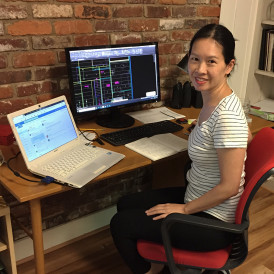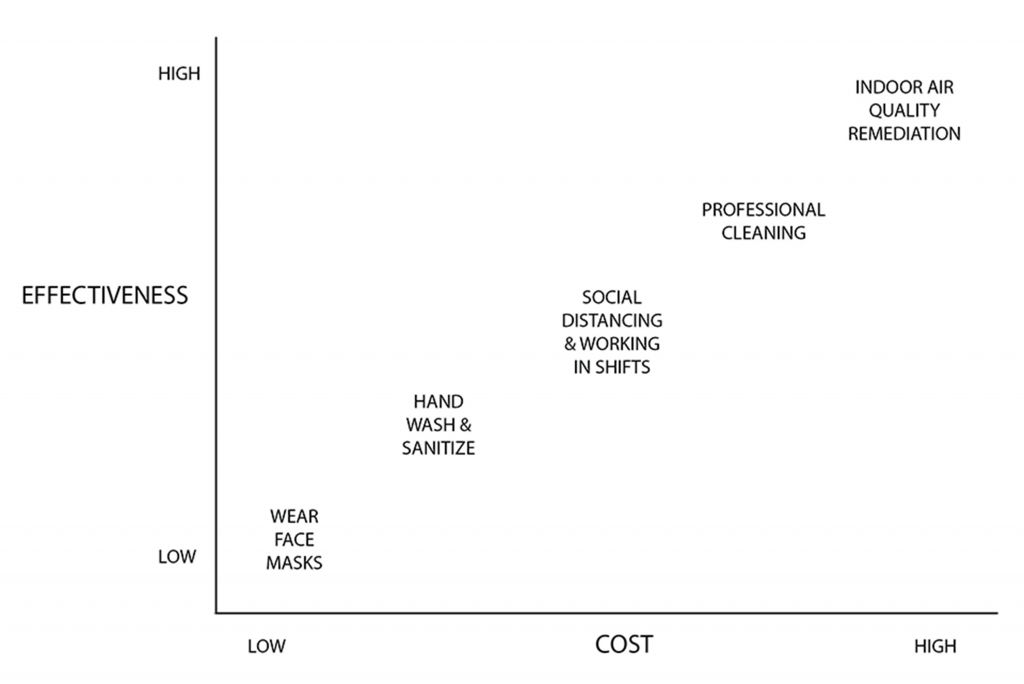
by Janice Wang, AIA, LEED AP
My husband and I need no alarm to wake us up in the morning – our 5-year-old daughter does the job. By the time we get up, our 8-year-old son is already awake and watching TV. I let the dog out and we all eat breakfast together. Then I head down to the ‘cave,’ our home office in the basement where I work the morning shift while my husband homeschools our kids in any place where they are willing to sit still. After lunch, we switch. We do a lot of playing and yard work outside when we need to escape the confines of our home. After we all have dinner and the kids are in bed, my husband and I usually continue working on our laptops at the dinner table to make up for the lost hours of work during the day. Even with this system in place, interruptions are frequent and there are many distractions. Work overlaps and often coincides with homeschool and childcare. But this is how we’ve managed to structure ‘the new normal.’
In our previous ‘normal,’ I achieved my work-life balance by establishing strict time constraints and distinct places for each role. My home was where I was a wife and mom in the morning and evening, and the office was where I worked as an architect during the day. Because of the pandemic, over the past eight weeks, those self-defined lines of schedule and boundaries have all been blurred.
This period of sheltering-in-place has presented the biggest challenge of my life to maintaining my work-life balance; but, we have made it work. We are all coronavirus-free. Lately, as China, Italy, Australia, and other countries around the world have begun to open up, North Carolina is gradually doing the same. Gov. Cooper has lifted restrictions, which don’t apply to our current telework setup, but which lay the groundwork for conversations around if and when we might return to our office.
Are we prepared?
Over the past few months, we’ve all learned that the most effective way to stay healthy is to shelter-in-place, but we can’t do this forever. The global economy is crippled and governments are reacting by allowing businesses to open up again. As a result, we have to ask ourselves, under what circumstances do I feel it’s safe to go back to my office?
As an architect who is able to work from home, I’m lucky enough to have an option, so it becomes a personal question. The deciding factors include a delicate balance of risks: health, financial, and mental. How much am I willing to risk getting sick? Am I at risk of losing my job if I continue to work from home and others go back to the office? What is the mental health risk of working in the office vs. from home?
At Szostak Design, we are considering how we can re-imagine our office to create a safe and more healthy working environment using the available data. Below is the preliminary framework we’ve developed to make an assessment and create an implementation plan.
Re-imagining the Szostak Design Office
On most days, 14-15 of our 20 employees work in our 3,500-SF space. (The additional five are our Szostak Build construction managers who are usually on site.) Aside from our firm principal and two administrators, we all sit in a big open studio space. Our desks are less than 6 feet apart from each other and we all breathe the same air. It’s evident that we will have to address issues of space, occupancy, and air quality in order to use our office again. Here are some of the questions we are asking ourselves.
Shelter: As architects, we design shelters – built environments that protect people from danger. At Szostak Design we’re asking ourselves, ‘What would it take to create a healthier work environment – one that protects our staff – while also maintaining an office that feels comfortable and amenable to daily work life?
Community: ‘How can we fulfill the need to maintain a sense of community and collaboration – the main reason for going to the office in the first place?’
In recent years, designers have promoted – and clients have requested – communal spaces to promote collaboration and multi-purpose spaces to maximize flexibility and adaptability. In our office, for example, we don’t have a full-sized kitchen or separate dining table, so we use our conference room as our multi-use communal space for meeting, gathering, and eating. However, as we continue to social distance, we will be without this shared space. If we want to share a meal together, we will have to find space outdoors. Adding a few picnic tables seems like a budget-friendly and reasonable way to break down the barriers we’ve been forced to build inside, but we don’t currently have permission to use the outdoor space surrounding our building. Can we find a creative solution?
Economics: Like many businesses in the middle of this financial recession, we have a limited budget to retrofit our office. So like many of you, we’re wondering, ‘What are the most cost-effective solutions we can implement so that we can work safely in our existing office environment?
Designing with Data
The Healthy Building Program from the Harvard Chan School of Public Health establishes a response framework for businesses to combat Covid-19 in their buildings: https://forhealth.org/. Figure 1 below is based on the Chan School analysis and weighs the effectiveness and financial impact of the actions listed below the graph.
In our office, these actions could have the following implications.
1. Health assessments and face masks:
- Employees with any symptoms of illness must stay home.
- Everyone in the office must wear a mask in case someone is sick, but is asymptomatic.
2. Hand-washing and sanitizing the bathrooms:
- Install touchless faucets, soap dispensers, and light switches.
- Install a foot pull to minimize contact with the door.
- Continue to practice proper handwashing and maintain a supply of hand sanitizer.
3. Maintaining social distance:
- Rearrange our desks so they are 6 feet apart and build higher dividers between desks.
- Work in shifts to reduce occupancy by 50%.
- Reduce the use of communal areas and equipment, i.e. prohibit the use of the microwave, coffee machine, and refrigerator; print only when necessary, and move the printer out of the open area and into a separate space.
- Use the very narrow hallway that connects the front office to the open studio space like a one-lane bridge – only one person can walk through the hallway at a time.
- Visitors are allowed only when necessary and they are only allowed in the front office and conference room. Visitors must wear a mask and maintain a 6-foot distance at all times.
- Space the conference room chairs 6 feet apart and limit the number of people in the room at any one time.
4. Thorough surface cleaning:
- Assign daily cleaning responsibilities. Currently, a professional service cleans the office once a week on Saturday. But ideally, the office should be cleaned at least once a day. Do we trust everyone in the office to properly clean their space on a daily basis? How do we monitor this?
5. Improving indoor air quality:
- Continue to wear masks.
- Improve our current mechanical air filtration system.
- Use of operable windows for fresh air.
Before the pandemic, these protocols may have seemed extreme. To many of us, our offices are our second homes. During a normal workweek, I spend more of my waking hours in my office and with my coworkers than in my home and with my family. But, the coronavirus is still raging across this country and we all still have to limit our exposure to protect ourselves, our families, and our community. The governor’s recent order to lift restrictions does not mean that the threat has diminished. If anything, preliminary studies show that the virus may spread more rapidly as restrictions are lifted. As I consider these recommendations, I re-visit the protocols that I’ve put in place with my family so that we can be productive but also stay healthy and happy while sheltering in place.
Many of these recommendations seem outside the scope of architecture and design since they rely on changing people’s behavior. But architecture and design are crucial in facilitating the behavioral changes we will all have to implement as we shelter both in- and out-of-place, until we can once again have a clear division between work and home.

